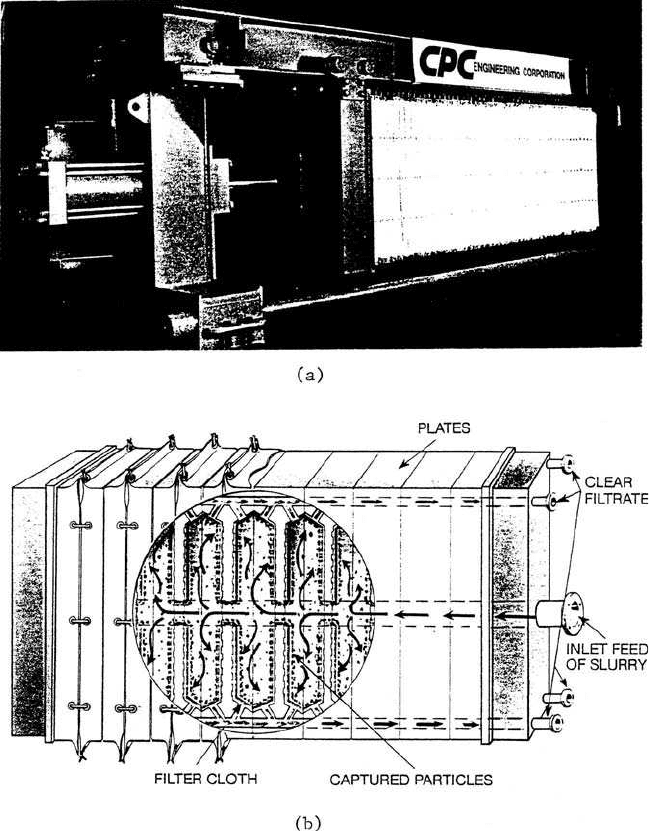Lin S.D. Water and Wastewater Calculations Manual
Подождите немного. Документ загружается.


K
d
⫽ 0.05 day
⫺1
P
v
⫽ 0.8
u
c
⫽ 60 days
The terms YS
i
is neglected, since no primary sludge is applied.
⫽ 1383 m
3
⫽ 48,860 ft
3
Step 6. Check the diffused air requirement per m
3
of digester volume,
from Step 4
⫽ 0.025 m
3
/(min ⭈ m
3
)
⫽ 25 L/min ⭈ m
3
⫽ 25 ft
3
/min/1000 ft
3
This value is at the lowest range of regulatory requirement, 25 to 35 L/min ⭈ m
3
.
Example 4: Determine the size of an aerobic digester to treat the primary
sludge of 590 kg/d (1300 lb/d) plus activated sludge of 380 kg/d (840 kg/d). Assume
the mixed sludge has a solids content of 3.8% and a retention time of 18 days.
solution:
Step 1. Calculate the mass of mixed sludge
Mass ⫽ (590 kg/d ⫹ 380 kg/d)/0.038
⫽ 25,530 kg/d
> 25.5 m
3
/d
Step 2. Calculate the volume (V ) of the aerobic digester
The volume of daily sludge production is approximately 25.5 m
3
/d, thus
V ⫽ 25.5 m
3
/d ⫻ 18 days
⫽ 459 m
3
Step 3. Check the solids loading rate assuming the solids are 80% volatile
VSS ⫽ (590 ⫹ 380) kg/d ⫻ 0.8 ⫽ 776 kg/d
Air 5
34.4 m
3
/min
1,383 m
3
5
58.8 m
3
/d 3 25,000 mg/L
18,750 mg/Ls0.05 day
21
3 0.8 1 1/60 daysd
V 5
Q
i
sX
i
1 YS
i
d
XsK
d
P
v
1 1/u
c
d
Wastewater Engineering 825
Loading rate ⫽ (776 kg VSS/d)/459 m
3
⫽ 1.69 kg VSS(m
3
⭈ d) [in the range of 1.1 to 3.2 kg VSS/(m
3
⭈ d)]
Lime stabilization. Chemical stabilization of wastewater sludge is an
alternative to biological stabilization. It involves chemical oxidation
(commonly using chlorine) and pH adjustment under basic conditions,
which is achieved by addition of lime or lime-containing matter. Chemical
oxidation is achieved by dosing the sludge with chlorine (or ozone, hydro-
gen peroxide). The sludge is deodorized and microbiological activities
slowed down. The sludge can then be dewatered and disposed of.
In the lime stabilization process, lime is added to sludge in sufficient
quantity to raise the pH to 12 or higher for a minimum of 2 h contact.
The highly alkaline environment will inactivate biological growth and
destroy pathogens. The sludge does not putrefy, create odors, or pose a
health hazard. However, if the pH drops below 11, renewed bacteria and
pathogen growth can reoccur. Since the addition of lime does not reduce
the volatile organics, the sludge must be further treated and disposed
of before the organic matter starts to putrefy again.
With 40 CFR Part 503 regulations (Federal Register, 1993) to reduce
pathogens, a supplemental heat system can be used to reduce the quan-
tity of lime required to obtain the proper temperature. Additional heat-
ing reduces the lime dosage and operating costs.
Composting. Composting is an aerobic biological decomposition of
organic material to a stable end product at an elevated temperature.
Some facilities have utilized anaerobic composting in a sanitary, nuisance-
free environment to create a stable humus-like material suitable for plant
growth. Approximately 20% to 30% of volatile solids are converted to
carbon dioxide and water at temperatures in the pasteurization range of
50 to 70⬚C (122 to 158⬚F). At these temperatures most enteric pathogens
are destroyed. Thermophilic bacteria are responsible for decomposing
organic matter. The finished compost has a moisture content of 40% to
50% and a volatile solids content of 40% or less (US EPA, 1991).
The optimum moisture content for composting is 50% to 60% water.
Dewatered wastewater sludges are generally too wet to meet optimum
composing conditions. If the moisture content is over 60% water, proper
structural integrity must be obtained. The dewatered sludge and bulk-
ing agent must be uniformly mixed. Sufficient air must be supplied to the
composting pile, either by forced aeration or windrow turning to main-
tain oxygen levels between 5% and 15%. Odor control may be required
on some sites.
In order to comply with the “process to significantly reduce pathogens”
(PSRP) requirements of 40 CFR Part 257 (Federal Register, 1993), the
compost pile must be maintained at a minimum operating temperature
826 Chapter 6
of 40⬚C (104⬚F) for at least 5 days. During this time, the temperature must
be allowed to increase above 55⬚C (131⬚F) for at least 4 h to ensure
pathogen destruction. In order to comply with the “process to further
reduce pathogens” (PFRP) requirements of 40 CFR Part 257 (Federal
Register, 1993), the in-vessel and static aerated compost piles must be
maintained at a minimum operating temperature of 55⬚C for at least
3 days. The windrow pile must be maintained at a minimum operating
temperature of 55⬚C for 15 days. In addition, there must be at least three
turnings of the compost pile during this period.
Sludge conditioning. Mechanically concentrated (thickened) sludges
and biologically and chemically stabilized sludges still require some
conditioning steps. Sludge conditioning can involve chemical and/or
physical treatment to enhance water removal. Sludge conditioning is
undertaken before sludge dewatering.
Details of process chemistry, design considerations, mechanical com-
ponents, system layout, operation, and costs of conditional methods are
presented in Sludge Conditioning Manual (WAPCF, 1988a). Some addi-
tional sludge conditioning processes disinfect sludge, control odors, alter
the nature of solids, provide limited solids destruction, and increase
solids recovery.
Chemical conditioning. Chemical conditioning can reduce the 90% to 99%
incoming sludge moisture content to 65% to 80%, depending on the nature
of the sludge to be treated (WPCF, 1988a). Chemical conditioning results
in coagulation of the solids and release of the absorbed water. Chemicals
used for sludge conditioning include inorganic compounds such as lime,
pebble quicklime, ferric chloride, alum, and organic polymers (polyelec-
trolytes). Addition of conditioning chemicals may increase the dry solids
of the sludge. Inorganic chemicals can increase the dry solids by 20% to
30%, but polymers do not increase the dry solids significantly.
Physical conditioning. The physical process includes using hot and cold
temperatures to change sludge characteristics. The commonly used phys-
ical conditioning methods are thermal conditioning and elutriation. Less
commonly used methods include freeze–thaw, solvent extraction, irra-
diation, and ultrasonic vibration.
The thermal conditioning (heat treatment) process involves heating
the sludge to a temperature of 177 to 240⬚C (350 to 464⬚F) in a reaction
vessel under pressure of 1720 to 2760 kN/m
2
(250 to 400 lb/in
2
[psig])
for a period of 15 to 40 min (US EPA, 1991). One modification of the
process involves the addition of a small amount of air. Heat coagulates
solids, breaks down the structure of microbial cells in waste activated
sludge, and releases the water bound in the cell. The heat-treated sludge
is sterilized and practically deodorized. It has excellent dewatering
Wastewater Engineering 827
characteristics and does not normally require chemical conditioning to
dewater well on mechanical equipment, Yielding cake solids concen-
trations of 40% to 50%.
Heat treatment is suitable for many types of sludge that cannot be sta-
bilized biologically due to the presence of toxic materials and is relatively
insensitive to change in sludge composition. However, the process pro-
duces liquid sidestreams with high concentrations of organics, ammonia
nitrogen, and color. Significant odorous off-gases are also generated
which must be collected and treated before release. The process has
high capital cost because of its mechanical complexity and the use of
corrosion-resistant material. It also requires close supervision, skilled
operators, and O and M programs. More detailed description of thermal
processing of sludge can be found elsewhere (WPCF, 1988a; WEF and
ASCE, 1991b).
A physical conditioning method used in the past is elutriation. In elu-
triation, a washing process, sludge is mixed with a liquid for the pur-
pose of transferring certain soluble organic or inorganic components to
the liquid. Wastewater effluent is usually used for elutriation. The
volume of wastewater is two to six times the volume of sludge. The elu-
triation of the sludge produces large volumes of liquid that contain a high
concentration of suspended solids. This liquid, when returned to the
treatment plant, increases the solids and organic loadings. Elutriation
tanks are designed to act as gravity thickeners with solids loading rates
of 39 to 49 kg/(m
2
⭈ d) (8 to 10 lb/(ft
2
⭈ d)) (Qasim, 1985).
Sludge dewatering. Following stabilization and/or conditioning, waste-
water sludge can be ultimately disposed of, or can be dewatered prior to
further treatment and/or ultimate disposal. It is generally more eco-
nomical to dewater before disposal. The primary objective of dewatering
is to reduce sludge moisture. Subsequently, it reduces the costs of pump-
ing and hauling to the disposal site. Dewatered sludge is easier to handle
than thickened or liquid sludge. Dewatering is also required before com-
posting, prior to sludge incineration, and prior to landfill. An advantage
of dewatering is that it makes the sludge odorless and nonputrescible.
Sludge can be dewatered by slow natural evaporation and percolation
(drying beds, drying lagoons) or by mechanical devices, mechanically
assisted physical means, such as vacuum filtration, pressure filtration,
centrifugation, or recessed plate filtration.
Vacuum filtration. Vacuum filtration has been used for wastewater
sludge dewatering for almost seven decades. Its use has declined owing
to competition from the belt press. A rotary vacuum filter consists of a
cylindrical drum covered with cloth of natural or synthetic fabric, coil
springs, or woven stainless steel mesh. The drum is partly submerged
(20% to 40%) in a vat containing the sludge to be dewatered.
828 Chapter 6

The filter drum is divided into compartments. In sequence, each com-
partment is subject to vacuums ranging from 38 to 75 cm (18 to 30 in)
of mercury. As it slowly rotates, vacuum is applied immediately under
the mat formation or sludge pick-up zone. Suction continues to dewa-
ter the solids adhering to the filter medium as it rotates out of the
liquid. This is called the drying zone of the cycle. The cake drying zone
represents from 40% to 60% of the drum surface. The vacuum is then
stopped, and the solids cake is removed to a sludge hopper or a conveyor.
The filter medium is washed by water sprays before reentering the vat.
For small plants, 35 h operation per week is often designed. This allows
daily 7 h operation with 1 h for start-up and wash-down. For larger
plants, vacuum filters are often operated for a period of 16 to 20 h/d
(Hammer, 1986).
Example: A 3 m (10 ft) diameter by 4.5 m (15 ft) long vacuum filter dewa-
ters 5400 kg/d primary plus secondary sludge solids. The filter is operated 7 h/d
with a drum cycle time of 4 min. The dewatered sludge has 25% solids con-
tent. The filter yield is 17.3 kg/(m
2
⭈ h). Determine the filter loading rate and
percent solids recovery. What is the daily operating hours required if the
dewatered sludge is 30% solids with the same percentage of solids recovery
and a filter yield of 9.8 kg/(m
2
⭈ h)?
solution:
Step 1. Compute the surface area of the filter
Area ⫽ p(3 m)(4.5 m) ⫽ 42.4 m
2
Step 2. Compute the filter loading rate
Step 3. Compute the percent solids recovery
Step 4. Compute the daily filter operation required with 30% solids
Since filter yield is determined by
Filter yield 5
solids loading 3 factor of recovery
h/d operation 3 filter area
5
95%
% 5
s17.3 kg/sm
2
#
hdd 3 100%
18.2 kg/sm
2
#
hd
5 3.7 lb/sft
2
#
hd
5 18.2 kg/sm
2
#
hd
Loading 5
solids loading
area 3 operating time
5
5400 kg/d
42.4 m
2
3 7 h/d
Wastewater Engineering 829

rearranging the above:
Pressure filtration. There are two types of pressure filtration process as
used for sludge dewatering. Normally, they are the belt filter press and
the plate and frame filter press. The operating mechanics of these two
filter press types are completely different. The belt filter press is popu-
lar due to availability of smaller sizes and uses polymer for chemical floc-
culation of the sludge. It consumes much less energy than the vacuum
filter. The plate and frame filter press is used primarily to dewater
chemical sludges. It is a large machine and uses lime and ferric chloride
for conditioning of organic sludge prior to dewatering. The filtered cake
is very compact and dry.
Belt filter press. A belt filter press consists of two endless, tensioned,
porous belts. The belts travel continuously over a series of rollers of
varied diameter that squeeze out the water from the sludge and produce
a dried cake that can be easily removed from the belts. Variations in belt
filter press design are available from different manufacturers.
Chemical conditioning of sludge is vital to the efficiency of a belt filter
press. Polymers are used as a conditioning agent, especially cationic
polymers. The operation of the belt filter press comprises three zones,
i.e. gravity drainage, low-pressure and high-pressure zones. Conditioned
sludge is first introduced uniformly to the gravity drainage zone and onto
the moving belt where it is allowed to thicken. The majority of free
water is removed from the sludge by gravity. Free water readily sepa-
rates from the slurry and is recycled back through the treatment system.
The efficiency of gravity drainage depends on the type of sludge, the
quality of the sludge, sludge conditioning, the belt screen mesh, and
design of the drainage section. Typically, gravity drainage occurs on a
flat or slightly inclined belt for a period of 1 to 2 min. A 5% to 10%
increase in solids content is achieved in this zone; that is, 1% to 5%
sludge feed produces 6% to 15% solids prior to compression (US EPA,
1991).
Following the gravity drainage zone, pressure is applied in the low-
pressure (wedge) zone. The pressure can come from the compression of
the sludge between two belts or from the application of a vacuum on the
lower belt. In the wedge zone, the thickened sludge is subjected to low
pressure to further remove water from the sludge matrix. This is to
5 12.3 h/d
5
5400 kg/d 3 0.95
9.8 kg/sm
2
#
hd 3 42.4 m
2
Operation, h/d 5
solids loading 3 factor of recovery
filter yield 3 filter area
830 Chapter 6

prepare an even firmer sludge cake that can withstand the shear forces
to which it is subjected by rollers.
On some units, the low-pressure zone is followed by a high-pressure
zone, where the sludge is sandwiched between porous belts and sub-
jected to shearing forces as the belts pass through a series of rollers of
decreasing diameter. The roller arrangement progressively increases the
pressure. The squeezing and shearing forces induce the further release
of additional amounts of water from the sludge cake.
The final dewatered filter cake is removed from the belts by scraper
blades into a hopper or conveyor belt for transfer to the sludge man-
agement area. After the cake is removed, a spray of water is applied to
wash and rinse the belts. The spray rinse water, together with the fil-
trate, is recycled back to primary or secondary treatment.
Belt filter presses are commercially available in metric sizes from 0.5
to 3.5 m in belt width, with the most common size between 1.0 and 2.5 m.
Hydraulic loading based on belt width varies from 25 to 100 gal/
(min ⭈ m) (1.6 to 6.3 L/(m ⭈ s)). Sludge loading rates range from 200 to
1500 lb/(m ⭈ h) (90 to 680 kg/(m ⭈ h)) (Metcalf and Eddy, Inc. 1991).
Typical operating parameters for belt filter press dewatering of polymer-
conditioned wastewater sludges are presented in Table 6.26.
Odor is often a problem with the belt filter press. Adequate ventilation
to remove hydrogen sulfide or other gases is also a safety consideration.
Wastewater Engineering 831
TABLE 6.26 Typical Operating Parameters for Belt Filter Press Dewatering of
Polymer Conditioned Sludge
Feed Hydraulic Solids Cake Polymer
solids, loading, loading, solids, dosage,
Type of sludge percent gal/(min ⭈ m
∗
) lb/(m
∗
⭈ h) percent lb/ton
Anaerobically digested
Primary 4–7 40–50 1000–1600 25–44 3–6
Primary plus WAS 2–6 40–50 500–1000 15–35 6–12
Aerobically digested 1–3 30–45 200–500 12–20 8–14
without primary
Raw primary and 3–6 40–50 800–1200 20–35 4–10
waste activated
Thickened waste 3–5 40–50 800–1000 14–20 6–8
activated
Extended aeration 1–3 30–45 200–500 11–22 8–14
waste activated
Heat-treated primary 4–8 35–50 1000–1800 25–50 1–2
plus waste activated
Notes: 1.0 gal/(min ⭈ m) ⫽ 0.225 m
3
/(m ⭈ h)
1.0 lb/(m ⭈ h) ⫽ 0.454 kg/(m ⭈ h)
1.1 lb/ton ⫽ 0.500 kg/tonne
∗
Loading per meter belt width
SOURCES: WPCF, 1983; Viessman and Hammer, 1993; WEF, 1996b

Hydrogen peroxide or potassium permanganate can be used to oxidize the
odor-causing chemical (H
2
S). Potassium permanganate can improve the
dewatering efficiency of the sludge and can reduce the quantity of poly-
mer required.
Example: A belt filter press (BFP) is designed to dewater anaerobically digested
primary plus waste activated sludge for 7 h/d and 5 d/wk. The effective belt width
is 2.0 m (commonly used). Estimate hydraulic and solids loading rates, poly-
mer dosage, and solids capture (recovery) with the following given data.
solution:
Step 1. Calculate the average weekly sludge production
Wet sludge ⫽ 20 gal/min ⫻ 1440 min/d ⫻ 7 d/wk ⫻ 8.34 lb/gal ⫻ 1.03
⫽ 1,731,780 lb/wk
Dry solids ⫽ 1,731,780 lb/wk ⫻ 0.035
⫽ 60,610 lb/wk
Step 2. Calculate daily and hourly dry solids dewatering requirement based
on the designed operation schedule: 7 h/d and 5 d/wk
Daily rate ⫽ (60,610 lb/wk)/(5 d/wk)
⫽ 12,120 lb/d
Hourly rate ⫽ (12,120 lb/d)/(7 h/d)
⫽ 1730 lb/h
Step 3. Select belt filter press size and calculate solids loading rate
Use one 2.0 m belt (most common size) and one more identical size for standby.
Calculate solids loading rate
Solids loading ⫽ (1730 lb/h)/2 m
⫽ 865 lb/(h ⭈ m) (OK, within 500 to 1000 lb/(h ⭈ m) range)
Step 4. Calculate hydraulic loading rate
Flow to the press ⫽ 20 gal/min ⫻ (7 days/5 days)(24 h/7 h)
⫽ 96 gal/min
Sludge production 20 gal/min
Total solids in sludge feed 3.5%
Total solids in cake 25%
Sp. gr. of sludge feed 1.03
Sp. gr. of dewatered cake 1.08
Sp. gr. of filtrate 1.01
Polymer dose (0.2% by weight) 7.2 gal/min
TSS in wastewater of BFP 1900 mg/L
Wash water 40 gal/min
832 Chapter 6

Wastewater Engineering 833
HL ⫽ 96 (gal/min)/2 m
⫽ 48 gal/(min ⭈ m)
(OK, within 40 to 50 gal/(min ⭈ m) range)
Step 5. Calculate dosage of polymer (0.2% by weight) with a 7.2 gal/min rate
⫽ 8.33 lb/ton
⫽ 4.16 kg/tonne
Step 6. Calculate solids recovery rate
(a) Estimate the volumetric flow of cake, q (from Step 4)
⫽ 12.4 gal/min
(b) Calculate flow rate of filtrate
Flow of filtrate ⫽ sludge feed flow ⫺ cake flow
⫽ 96 gal/min ⫺ 12.4 gal/min
⫽ 83.6 gal/min
(c) Calculate total solids in the filtrate of wastewater from the press
(d) Calculate solids capture (recovery)
Plate and frame filter press. There are several types of filter press avail-
able. The most common type, the plate and frame filter press, consists
of vertical plates that are held rigidly in a frame and pressed together
between fixed and moving ends (Fig. 6.61a). As shown in Fig. 6.61b, each
chamber is formed by paired recessed plates. A series of individual
5 95.4%
5
s865 2 40d lb/sh
#
md 3 100%
865 lb/sh
#
md
Solids caputre 5
solids in feed 2 solids in filtrate
solids in feed
3 100%
5 40lb/sh
#
md
Solids 5
83.6 gal/min 3 60 min/h 3 1900 mg/L 3 8.34 lb/gal
2.0 m 3 1,000,000 mg/L
q 5
96 gal/min 3 0.035
s25%/100%d 3 1.08
Dosage 5
s7.2 gal/min 3 60 min/h 3 0.002d 3 8.34 lb/gal
2.0 m 3 865 lb/sh
#
md 3 s1 ton/2000 lbd

chambers have a common feed port and two or more common filtrate
channels. Fabric filter media are mounted on the face of each indi-
vidual plate, thus providing initial solids capture.
The filter press operates in batch manner to dewater sludge. Despite
its name, the filter press does not press or squeeze sludge. Instead,
when the filter is closed, the recessed faces of adjacent plates form a
834 Chapter 6
Figure 6.61 Plate and frame filter press: (a) side view of a filter press; (b) schematic cross
section of chamber area during fill cycle.
